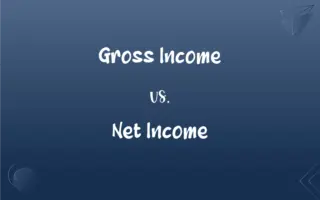Machine Cycle vs. Instruction Cycle: What's the Difference?
Edited by Aimie Carlson || By Harlon Moss || Updated on October 2, 2023
The machine cycle is the basic operation cycle of a computer, while the instruction cycle is a series of machine cycles executing a program instruction.

Key Differences
Machine cycle refers to the fundamental sequence of operations that a central processing unit (CPU) performs to execute a single basic operation such as fetching data, reading data, or writing data. Each machine cycle encompasses a specified number of clock cycles to retrieve and execute a basic operation. Within a machine cycle, data might be fetched or written, and computations at a basic level are executed, but it might not involve the execution of a complete instruction from a program.
On the other hand, the instruction cycle pertains to the series of steps or stages involved in the execution of a single instruction in a program. An instruction cycle consists of multiple machine cycles and performs all the activities required to fetch, decode, and execute an instruction, and, if necessary, store the result. So, in essence, while a machine cycle is about basic operational steps, an instruction cycle relates to the execution of an entire instruction.
Machine cycles are integral parts of an instruction cycle, often composed of several machine cycles working in harmony to execute a single instruction. The intricacies of both cycles involve numerous operations in computer architecture, where machine cycles handle fundamental operations and instruction cycles manage the execution of instructions through multiple phases, including fetching, decoding, executing, and storing the results, each of which might involve one or more machine cycles.
Machine cycles are typically shorter in duration compared to instruction cycles, considering the latter encompasses multiple machine cycles. A single machine cycle might be completed in one to several clock cycles, determined by the microarchitecture of the CPU. Conversely, an instruction cycle, due to its comprehensive involvement in dealing with entire instructions, naturally encapsulates more operations, requiring multiple machine cycles, and thereby, many more clock cycles.
The hierarchical nature and complexity of these cycles unveil the meticulous organization of computational operations in a processor. Machine cycles operate at a lower, more fundamental level, dealing with basic operations and data transfers. In contrast, instruction cycles operate at a comparatively higher level, directing the CPU through the entire process of fetching and executing a program instruction, which, in return, is accomplished through several machine cycles.
ADVERTISEMENT
Comparison Chart
Definition
Basic operation cycle of the CPU.
Sequence of steps to fetch, decode, and execute an instruction.
Duration
Typically shorter, involving fewer clock cycles.
Longer, involving multiple machine and therefore clock cycles.
Function
Performs basic operations like reading and writing.
Manages the entire execution of a single instruction.
Level of Operation
Lower level, deals with basic CPU operations.
Higher level, dealing with instruction execution.
Constituent Components
May consist of one phase.
Consists of multiple phases: fetch, decode, and execute.
ADVERTISEMENT
Machine Cycle and Instruction Cycle Definitions
Machine Cycle
A machine cycle encompasses the steps a CPU takes to execute a basic operation.
The processor performs the read operation during one machine cycle.
Instruction Cycle
An instruction cycle includes multiple machine cycles.
The execute phase might involve several machine cycles to complete.
Machine Cycle
Machine cycles are the building blocks of instruction cycles.
Multiple machine cycles are utilized within one instruction cycle.
Instruction Cycle
Instruction cycles are pivotal for controlling data flow in computational operations.
The store phase of the instruction cycle saves computed data back to memory.
Machine Cycle
Machine cycles can be classified based on operations such as fetching, reading, and writing.
The fetch machine cycle retrieves data from memory.
Instruction Cycle
The instruction cycle is integral to program execution in a CPU.
During the instruction cycle, the CPU ensures that instructions execute sequentially.
Machine Cycle
A machine cycle is comprised of a specific number of clock cycles.
A single machine cycle might take three clock cycles to complete.
Instruction Cycle
The instruction cycle involves fetching, decoding, executing, and optionally storing the result of an instruction.
The CPU enters the fetch phase at the start of the instruction cycle.
Machine Cycle
A machine cycle represents fundamental CPU operations.
The write machine cycle saves data into memory.
Instruction Cycle
Instruction cycles control the execution of program instructions.
The decode phase of the instruction cycle interprets the opcode.
FAQs
What occurs during a Machine Cycle?
Basic operations, such as fetching, reading, writing, or executing, occur during a machine cycle, involving several clock cycles.
What is a Machine Cycle?
A machine cycle is a series of steps a CPU takes to process a basic operation such as fetch, decode, execute, and store.
How does an Instruction Cycle function?
An instruction cycle fetches, decodes, executes a single instruction, and optionally stores the result, involving several machine cycles.
How does decoding work in an Instruction Cycle?
Decoding translates the fetched instruction into control signals that direct the subsequent execution phase.
Is the execution of an instruction always completed in a single Machine Cycle?
No, executing an instruction typically involves multiple machine cycles within one instruction cycle.
What influences the duration of a Machine Cycle?
Factors such as the CPU’s microarchitecture, clock speed, and the specific operation being performed influence the duration of a machine cycle.
What is the fetch operation in an Instruction Cycle?
The fetch operation retrieves an instruction from memory, signaling the beginning of an instruction cycle.
How does pipeline processing relate to Instruction Cycles?
Pipeline processing allows CPUs to begin processing a new instruction cycle before the previous one is finished, enhancing efficiency.
How do Machine Cycles and Instruction Cycles relate?
Machine cycles are fundamental operations that collectively comprise an instruction cycle, enabling instruction execution.
Are Machine Cycles dependent on Instruction Cycles?
No, machine cycles function independently but collectively facilitate the execution of an instruction cycle.
Can a Machine Cycle operate without an Instruction Cycle?
While theoretically possible, machine cycles typically function within the context of an instruction cycle in practical computing.
Can Instruction Cycles occur simultaneously?
In certain multi-threading or parallel processing architectures, multiple instruction cycles may overlap or occur simultaneously.
What happens if a Machine Cycle is interrupted?
Interruptions during a machine cycle typically cause the CPU to pause or halt, potentially triggering error-handling procedures.
What role does the clock cycle play in a Machine Cycle?
A machine cycle consists of several clock cycles, which are periods during which the CPU performs fundamental operations.
How does a CPU utilize Machine Cycles?
The CPU utilizes machine cycles to perform basic operations which, when combined, enable the execution of instructions.
Why is understanding Machine Cycles crucial for programmers?
Understanding machine cycles helps programmers optimize code, ensuring efficient use of CPU resources and enhancing performance.
What impact do Machine Cycles have on computational speed?
Shorter machine cycles and efficient utilization often enable faster computational speeds, as the CPU can process basic operations more rapidly.
How many Machine Cycles are in an Instruction Cycle?
The number of machine cycles within an instruction cycle varies, depending on the complexity and type of the instruction being processed.
What constitutes the storage phase in an Instruction Cycle?
The storage phase, if present, saves the result of the executed instruction back into memory or a register.
How does the CPU know when to start an Instruction Cycle?
The CPU utilizes a program counter to determine the memory address of the next instruction, initiating the instruction cycle.
About Author
Written by
Harlon MossHarlon is a seasoned quality moderator and accomplished content writer for Difference Wiki. An alumnus of the prestigious University of California, he earned his degree in Computer Science. Leveraging his academic background, Harlon brings a meticulous and informed perspective to his work, ensuring content accuracy and excellence.
Edited by
Aimie CarlsonAimie Carlson, holding a master's degree in English literature, is a fervent English language enthusiast. She lends her writing talents to Difference Wiki, a prominent website that specializes in comparisons, offering readers insightful analyses that both captivate and inform.































































